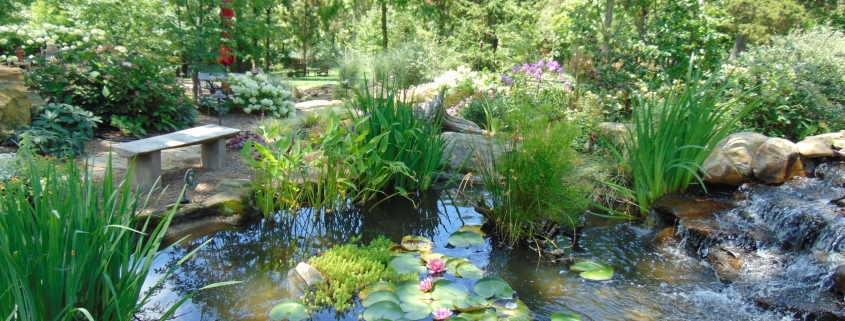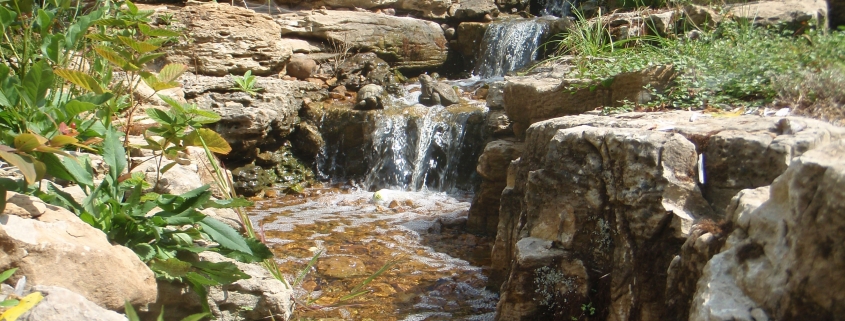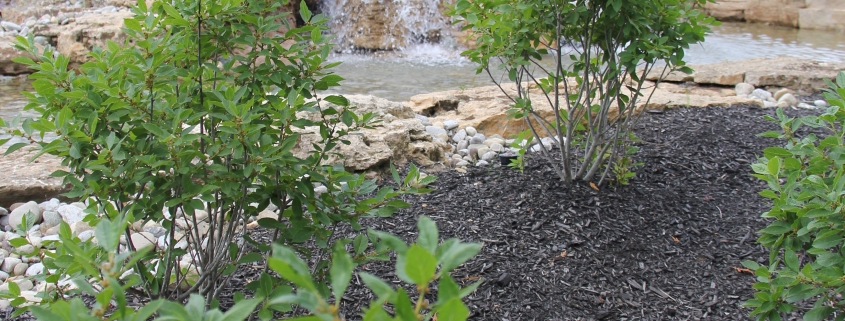How to Shock a Pond Quick How-To Guide
If fish are dying in your pond or if you see lots of algae, it may be time to shock the pond to clean it up. Algae needs oxygen to grow, just as fish and aquatic vegetation do. However, too much algae can rob fish and plants of the oxygen they need. Shocking your pond and getting rid of the harmful algae can restore the clean, clear look to you pond. Because desirable plants and animals live in ponds, owners look for natural enzymes and organic compounds to clear the water. Chlorine should only be used as a last resort.
Remove all dead or decaying plant and animal life from the pond. Algae feeds on the decay process.
Place the correct amount of algaecide in your pond according to manufacturer’s directions. For example, if you have a 120-gallon pond, you would need to use 2 teaspoons of general Algaecide. Each algaecide is different, so read the directions closely.
Let the pond pump aerate and spread the algaecide. If algae is still present after a week, shock the pond again.
Botanical Wonders in Water Gardens
Water gardens are living canvases where art and nature meet. The lush greenery and vibrant blooms of aquatic plants add dynamic beauty, support local ecosystems, and create a sense of tranquility that is both captivating and restorative. Today, we’ll explore a variety of plants that can transform your water garden into a thriving, colorful oasis. 🌿
Floating Beauties
Floating plants are among the most eye-catching additions to a water garden. Water lilies are a timeless favorite, with their broad, flat leaves providing ample shade while their blossoms introduce an array of colors. These plants not only enhance the garden’s aesthetic but also play a vital role in controlling algae growth by limiting sunlight penetration. Lotus is another stunning option; its large, fragrant flowers and broad leaves create a dramatic focal point that exudes elegance.
Submerged and Marginal Marvels
Submerged plants, such as anacharis and hornwort, serve as the underwater architects of your water garden. They help maintain water clarity and oxygenation, essential for a healthy aquatic ecosystem. In the marginal zones, where water meets land, pickerel rush and water iris flourish. These plants thrive at the water’s edge, offering a transition between aquatic and terrestrial life while providing habitat for small aquatic creatures.
Emergent Plants
Emergent plants like cattails and water lilies (different from their floating counterparts) rise gracefully from the water. These plants are ideal for adding vertical interest and texture. Cattails, for instance, lend a natural, wild look to the garden and are superb for filtering water by absorbing excess nutrients. Their long, slender leaves create movement in the breeze, which adds to the garden’s dynamic feel.
Floating and Floating-Marginal Hybrids
Plants such as water hyacinth and duckweed float effortlessly on the water’s surface. While water hyacinth offers vibrant purple blooms, duckweed provides a lush, green blanket that can help prevent excessive evaporation and suppress algae. However, it’s essential to monitor these plants closely, as they can multiply quickly under favorable conditions. Managing their growth will keep your garden balanced and visually appealing.
Selecting the Right Plants
Choosing the ideal plants for your water garden requires a thoughtful understanding of your specific conditions—water depth, sunlight exposure, and local climate all play crucial roles. Consider these tips:
- Sunlight Needs: Some aquatic plants thrive in full sun, while others prefer partial shade. Water lilies typically perform best with plenty of direct sunlight, ensuring robust flowering.
- Water Depth: Different plants require varying water depths. Lotus, for example, needs deeper water compared to water lilies, which are more adaptable to shallower conditions.
- Maintenance: Balance the visual appeal of fast-growing species like duckweed with the ease of managing invasive varieties. Regular trimming and seasonal maintenance can keep your garden in harmony.
Final Thoughts
Incorporating a diverse mix of aquatic plants can elevate your water garden into a living masterpiece. From the gentle elegance of water lilies and lotus to the practical benefits of submerged and emergent species, every plant contributes to a balanced ecosystem that supports wildlife and enhances outdoor beauty. Embrace these botanical wonders, experiment with different textures and colors, and let your water garden flourish as a testament to nature’s artistry. 😊
Sustainable Flow, Smart Savings
Water conservation is a critical element in designing and maintaining water features and ponds that are both beautiful and eco-friendly. By employing efficient technologies and thoughtful design strategies, you can enjoy the calming sounds and stunning visuals of water installations while also minimizing water waste. In today’s environmentally conscious world, embracing water conservation not only benefits the planet but also ensures that your garden or outdoor space remains a long-lasting retreat. 💧
The Importance of Water Conservation
Water features and ponds often require a steady supply of water to maintain clarity and create their desired effects. However, excessive water usage can lead to unnecessary waste and higher utility bills. By focusing on water conservation, you can reduce your environmental footprint and achieve a more sustainable garden. Implementing efficient recirculating systems ensures that water is continuously filtered and reused, keeping the installation fresh without constantly drawing from external sources.
Efficient Recirculating Systems
Modern water installations incorporate recirculating systems that work to filter, oxygenate, and maintain water quality. These systems are designed to reuse the same water, minimizing waste and the need for frequent refills. Energy-efficient pumps, like the Aquascape Ultra series, play a vital role in these systems. They provide reliable circulation while consuming less energy, making them a smart choice for those who want to balance performance with conservation.
Key benefits of recirculating systems include:
- Reduced Water Waste: Water is continually reused, cutting down on the need for constant refills.
- Improved Water Quality: Filters and clarifiers help remove debris and prevent algae buildup.
- Lower Energy Consumption: Energy-efficient pumps ensure that your water feature remains eco-friendly and cost-effective.
Design Strategies for Conservation
Thoughtful design choices also contribute significantly to water conservation. Consider these strategies when planning your water feature or pond:
- Optimize Basin Size: Choose a basin or reservoir that suits the scale of your installation. A properly sized basin minimizes evaporation while maintaining the desired water volume.
- Use Natural Filtration: Incorporate aquatic plants that naturally filter and oxygenate the water. Native species can thrive in your local climate and reduce the need for chemical treatments.
- Incorporate UV Clarifiers: UV clarifiers can help control algae growth without the need for additional chemicals, preserving both water quality and natural balance.
- Shade and Shelter: Strategically placed landscaping elements can provide shade over the water, reducing evaporation and keeping water temperatures stable.
Long-Term Benefits of Water Conservation
Investing in water conservation techniques offers both immediate and long-term rewards. For your garden, these practices result in a more stable and sustainable ecosystem. Additionally, conserving water helps reduce overall maintenance requirements and operational costs. As water conservation becomes an integral part of outdoor design, you also contribute to broader environmental goals, ensuring that resources are used wisely for generations to come.
Final Thoughts
By integrating water conservation methods into your water features and ponds, you create a harmonious blend of aesthetics and efficiency. Whether it’s through advanced recirculating systems, smart design choices, or energy-efficient technologies, sustainable water management enhances the beauty and functionality of your outdoor space. Embrace these practices to enjoy a serene, eco-friendly oasis that not only captivates the senses but also champions a responsible approach to nature. 😊
Check out our store for all your water gardening needs! Aquascape products are Aquascape Inc. Certified.
Thanks for reading at Meyer Aquascapes! We hope you’ve enjoyed our post on garden pond design. Please leave a comment below if you liked it or have any questions. We’d love to hear from you! Thanks for stopping by!
Eco-Friendly Water Features
Sustainable water features represent the future of outdoor design—where aesthetic appeal meets environmental responsibility. As water conservation and energy efficiency become increasingly important, these eco-friendly installations are designed not only to enchant your garden but also to promote a healthier ecosystem. Embracing sustainable water features means investing in both beauty and the well-being of our planet. 🌿
Designing with Sustainability in Mind
At the core of sustainable water features is a commitment to reducing water waste and minimizing energy consumption. Modern installations often incorporate recirculating systems that continuously reuse water, dramatically cutting down on the need for constant refills. Energy-efficient pumps, such as those from the Aquascape Ultra series, are engineered to operate quietly while using less power, ensuring that your water feature remains both environmentally and economically friendly.
Sustainability in water features isn’t just about technology—it’s about thoughtful design. By selecting materials that are durable and locally sourced, you not only reduce your carbon footprint but also create installations that withstand the test of time. Natural stone, recycled metals, and eco-friendly composites are just a few examples of materials that lend an organic feel to your water display while supporting sustainable practices.
Benefits of Sustainable Water Features
Water Conservation:
One of the primary advantages of sustainable water features is their efficient water use. Recirculation systems ensure that every drop is used to its fullest potential, allowing you to enjoy the soothing sound of flowing water without unnecessary waste.
Energy Efficiency:
With energy-efficient pumps and LED lighting, sustainable water features offer a lower energy consumption profile. Modern LED fixtures not only highlight the beauty of your installation but also consume a fraction of the energy used by traditional lighting systems.
Enhanced Ecosystems:
Eco-friendly water installations can serve as mini-ecosystems, encouraging biodiversity. By integrating native aquatic plants and creating natural filtration zones, these features help maintain clean water and provide habitats for beneficial wildlife. This not only beautifies your space but also contributes to local ecological health.
Practical Steps to Create a Sustainable Water Feature
- Plan for Recirculation:
Begin with a design that prioritizes water recirculation. Choose a pump that matches the size and style of your installation. Pumps like the Aquascape Ultra series offer adjustable settings that let you fine-tune water flow, ensuring optimal performance without wasting energy. - Select Eco-Friendly Materials:
Opt for sustainable materials that blend seamlessly with your garden’s natural landscape. Natural stone and recycled materials can add texture and durability to your installation, reducing the need for frequent repairs or replacements. - Integrate Native Plant Life:
Incorporate aquatic plants that naturally filter and oxygenate the water. Native species are better adapted to your local climate, reducing the need for chemical treatments and extensive maintenance. - Utilize LED Lighting:
Enhance your water feature with low-voltage LED lighting. Energy-efficient and long-lasting, LEDs can be strategically placed to illuminate the water, creating a captivating nighttime display that’s both safe and sustainable.
A Forward-Thinking Approach
Investing in sustainable water features is not just a design choice; it’s a commitment to the future. These installations exemplify how beauty and sustainability can coexist, transforming outdoor spaces into serene retreats that nurture both the mind and the environment. By choosing eco-friendly water features, you are embracing a modern, forward-thinking approach that benefits your garden and the world at large.
Let your garden be a testament to innovation and environmental stewardship—one that inspires others to make eco-conscious choices. 😊

 meyer aquascapes
meyer aquascapes meyer aquascapes
meyer aquascapes

